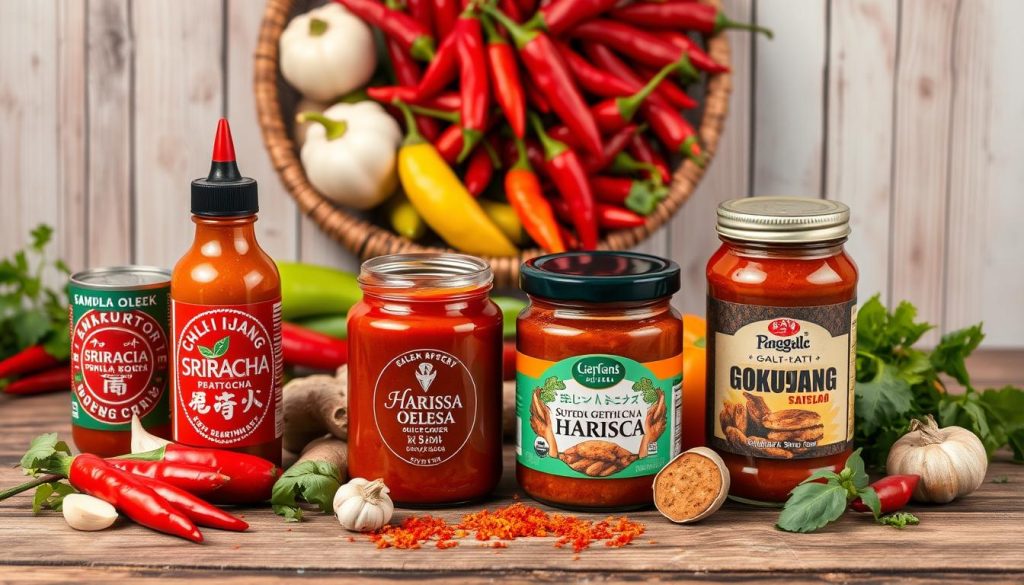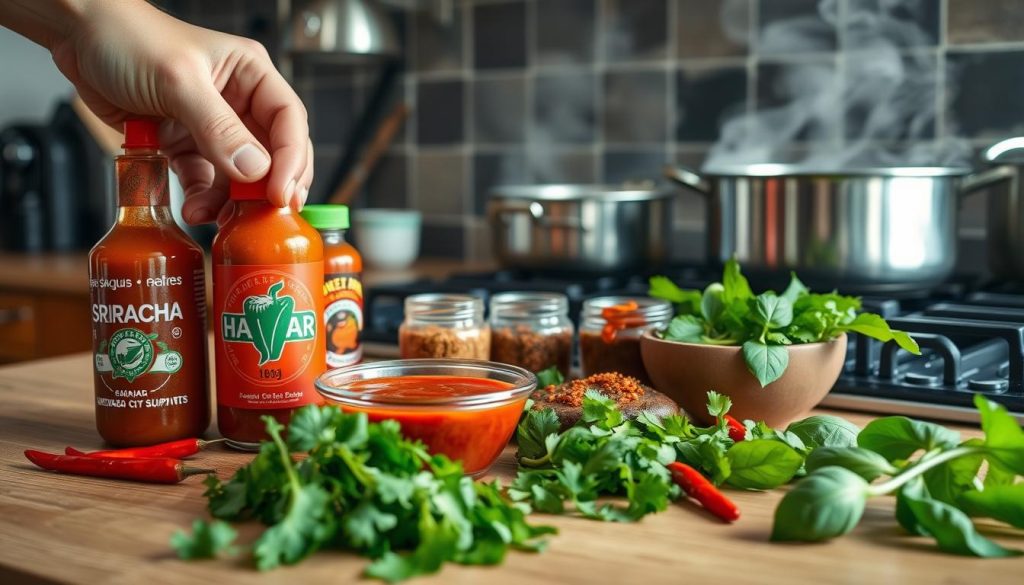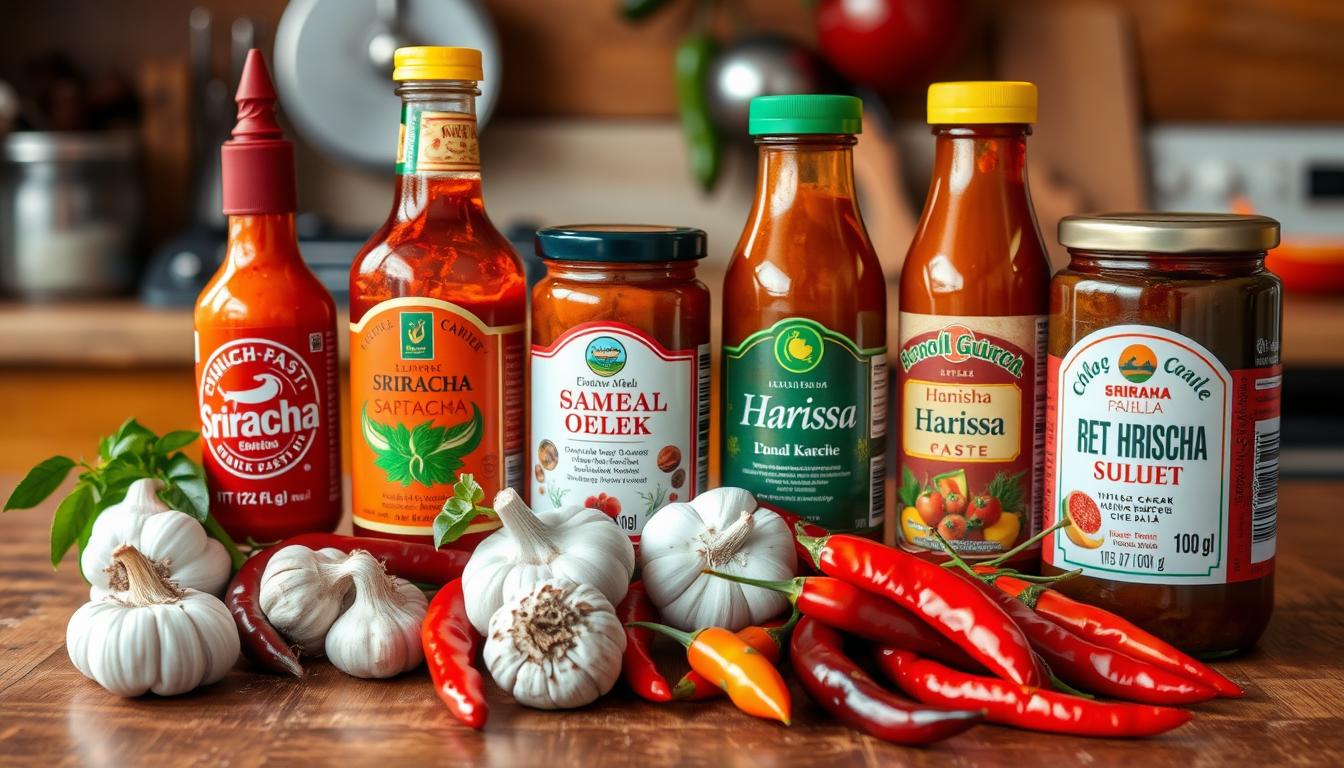Chili paste is a favorite among chefs and home cooks. It brings heat and flavor to many dishes. But, what if you need a chili paste substitute? Don’t worry, we’ve got you covered.
This guide will help you understand chili paste and find great alternatives. Whether you’re cooking with chili paste or need a spicy substitute, we’ll show you how to keep your meals flavorful and exciting. You can do this even when you don’t have chili paste.
Understanding Chili Paste: What Makes It Special
Chili paste is a standout in cooking because of its special ingredients and the variety found around the world. You might ask, what is chili paste? It’s a blend of concentrated chili peppers mixed with liquids like vinegar or water. The ingredients can change based on where it’s made and who makes it, affecting its heat and taste.
The Components of Chili Paste
The heart of chili paste is made from dried chilies and flavor boosters like garlic and salt. There are many types of chili paste, each offering a unique taste, from hot to sweet. Commercial versions might have extra ingredients, and different makers can create different flavors.
Regional Variations in Chili Paste
Chili paste varies greatly around the world, influenced by local tastes and traditions. In the U.S., especially Texas, chili paste is key to a beloved dish. Texas even named chili its official food, showing its importance. Other places have their own special chili pastes, like:
| Region | Chili Paste | Main Ingredients |
|---|---|---|
| Hungary | Piros Arany | Chili peppers |
| China | La Jiao Jiang | Hot chili, often from Huy Fong |
| Peru | Salsa de Rocoto | Rocoto peppers |
| Ghana | Shito | Dried fish, ginger, oil |
| Northern Africa | Harissa | Red chile peppers, vinegar, garlic |
| Georgia | Ajika | Hot peppers, walnuts, spices |
| Turkey | Biber Salçası | Sun-dried red chile peppers, salt |
This table shows some of the many chili pastes and their ingredients, highlighting its global appeal. The mix of local ingredients and personal tastes leads to a wide range of flavors. This makes chili paste a key ingredient in kitchens everywhere.
Why Substitute Chili Paste?
There are many reasons to substitute chili paste in your cooking. Running out of chili paste often pushes you to explore different options while still achieving the desired flavor. You might also want to customize your dishes by adjusting spice levels based on personal preferences. Whether you seek mild warmth or intense heat, knowing how to navigate chili paste alternatives expands your culinary possibilities.
When You’re Out of Chili Paste
Being out of chili paste doesn’t mean your cooking has to suffer. Several chili paste alternatives can keep your meals vibrant and spicy. Consider sambal oelek, harissa, or hot sauces such as Sriracha. These options often feature similar flavors that can work well in various recipes. Homemade chili paste using fresh red chilies is also an excellent choice for those who wish to create their unique blends.
Tailoring Heat Levels for Different Dishes
Adjusting spice levels enhances the dining experience, allowing you to cater dishes to the tastes of your guests. If you desire a milder flavor, incorporating a bit of tomato paste or adding lime juice can lower the heat. Alternatively, for those craving more spice, mixing in crushed red pepper flakes or cayenne pepper can bring your dish to the desired intensity. Understanding how to balance flavors with these chili paste alternatives not only optimizes the taste but also elevates your culinary skills.
Exploring Your Options: Popular Chili Paste Substitutes
When you’re out of chili paste, don’t worry. There are many alternatives that can add heat and flavor to your dishes. Knowing the best substitutes can make cooking easier and more fun. Let’s look at some popular options that can replace chili paste and make your meals better.
Sambal Oelek: The Simple Solution
Sambal oelek is a simple yet flavorful choice. It’s made from crushed red chilies, salt, and vinegar. This gives it a fresh pepper taste. It’s great because it has no added sugars or extra flavors, keeping your dish simple yet spicy.
Curry Paste: A Flavorful Alternative
Curry paste is a flavorful substitute that can change your meals. It comes in many blends, with spices like turmeric, cumin, and coriander. You can use it in the same amount as chili paste, adding a spicy kick without overwhelming your dish.
Sriracha: Sweet and Spicy Choice
Sriracha sauce is a sweet and slightly garlicky option. It’s from Thailand and can vary in heat. Start with half the amount of chili paste and adjust to taste. It’s great for marinades and dipping sauces, adding heat and sweetness.
Gochujang: The Fermented Flavor Powerhouse
Gochujang is a fermented Korean chili paste. It has a rich, earthy flavor and moderate heat. Made with glutinous rice, it has a unique texture and sweetness. It’s a great substitute for a deeper flavor profile in your cooking.

Your Ultimate Sub for Chili Paste Guide
Replacing chili paste in your recipes can make your cooking better. It keeps the flavor you want. Knowing how to use chili paste substitutes is key to great taste.
How to Use Each Substitute Effectively
Each substitute has its own flavor and heat. For example, sambal oelek is a 1:1 substitute for heat. Gochujang is sweeter, so adjust your seasoning. Here are more options:
- Sambal Oelek: Use directly in equal measure as a chili paste replacement.
- Curry Paste: Start with half the amount required and taste before adding more.
- Sriracha: This can add sweetness, so be mindful when substituting; use about 3/4 the amount of chili paste.
- Gochujang: Begin with a smaller amount (about 2/3) and adjust based on your flavor preference.
Adjusting Ratios for Flavor Balance
Getting flavors right is key to great dishes. When you substitute chili paste, adjusting ratios is important. Here’s how:
- Taste as You Go: Always sample your dish after adding substitutes. This practice assists in fine-tuning the balance of flavors.
- Pair with Complementary Ingredients: Consider ingredients like olive oil and vinegar, which blend well with most chili substitutes and aid in flavor balance.
- Monitor Heat Levels: Be aware of the Scoville heat units of the peppers in your substitutes. This awareness allows you to adjust quantities to create a comfortable level of spice.

Different peppers have different heat levels. Bell peppers have no heat, while jalapenos are moderately spicy. Knowing this helps you use substitutes well and balance flavors.
Tips for Creating Your Homemade Chili Paste Substitutes
Creating your own chili paste substitutes can really enhance your cooking. By picking fresh ingredients, you can make a flavor that’s just right for you. Making homemade chili paste is all about trying new things and finding the perfect mix of tastes and heat.
Customizing Ingredients for Personal Taste
When making your own chili paste, think about using different dried chiles. You can find these in most supermarkets or Latin markets. Choosing chiles from various categories can make your paste even better.
- Sweet and Fresh: These chiles have a mild taste.
- Hot: Great for adding a spicy touch.
- Smoky: Adds depth to the flavor.
- Rich and Fruity: Brings a unique sweetness and complexity.
It’s a good idea to pick at least one pepper from each category for a rich flavor. Make sure the dried chiles are soft and pliable. If they’re hard or crackly, they’re too old. Store any leftover chiles in an airtight bag in the freezer to keep them fresh.
Experimenting with Heat and Flavor
When experimenting with flavors, start by cleaning, toasting, and blending your chiles. Use about four tablespoons of chili purée for every tablespoon of chili powder in your recipe. Simmering the chiles in chicken stock or water before blending can make them taste even better and smoother.
Here’s a simple recipe for homemade chili paste:
| Ingredients | Quantity |
|---|---|
| Chili Peppers (chopped) | 1 pound |
| Garlic cloves (chopped) | 2 |
| Shallots (chopped) | 2 small |
| Olive Oil | ¼ cup (more if needed) |
| Cumin | ½ teaspoon |
| Salt and Pepper | To taste |
This recipe makes about 1.5 cups of chili paste. You can keep it in the fridge for up to a week. For longer storage, freeze it in ice cube trays for up to six months. Making your own chili paste can really add to your cooking and let you explore new flavors.
Conclusion
Understanding chili paste and its substitutes can really boost your cooking skills. You can use ingredients like sambal oelek, sriracha, and homemade blends to change the heat and taste of your food. Mixing sriracha with honey gives a sweet and spicy flavor, while a homemade mix of chili flakes and sugar adds a unique twist.
This guide also opens up new possibilities in the world of spices and their health benefits. Adding spicy ketchup or hoisin sauce to your recipes keeps things interesting. With these tips, you’ll be ready to tackle any recipe that calls for chili paste. Your dishes will be both varied and exciting.
Source Links
- https://www.alsothecrumbsplease.com/chili-paste-substitutes/
- https://www.spiceandlife.com/chili-paste-substitute/
- https://www.chefspencil.com/chili-paste-substitute/
- https://www.texasrealfood.com/promptuary/condiments/chili-paste/
- https://food52.com/blog/12484-a-chili-paste-primer?srsltid=AfmBOoq1VlykyCxp4UjyLql11XO3phTbYjZA5C6YzLEMOwhNCvHpwZhA
- https://pepperscale.com/chili-paste-substitute/
- https://pepperscale.com/chili-paste-vs-chili-sauce/
- https://pipandebby.com/pip-ebby/chili-paste/
- https://www.alsothecrumbsplease.com/calabrian-chili-paste-substitute/
- https://gustomeadow.com/chili-paste-substitutes/
- https://www.alphafoodie.com/how-to-make-red-chili-paste/
- https://www.howtocook.recipes/homemade-chili-paste-recipe/
- https://www.seriouseats.com/chili-puree-replace-chili-powder-recipe
- https://www.chilipeppermadness.com/chili-pepper-recipes/sauces/fresh-chili-paste-how-to-make-chili-paste-from-fresh-peppers/
- https://www.eatyourbeets.com/best-substitution-for-sweet-chili-sauce/
- https://www.cleaneatingkitchen.com/best-substitutes-for-chili-peppers/
